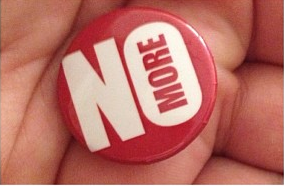How to talk to your kids about the #NoMore Campaign
What am I supposed to say about that? A parent’s guide to answering questions about the No More Campaign.
Some parents feel a little overwhelmed when they are confronted with a serious adult issue like sexual violence. How you respond obviously depends upon both you and your values, and your child and their developmental stage. Here are some ideas for how to respond. Please feel free to reach out to a social service agency like the Sexual Assault Centre if you need more information or support of any kind. See www.taylorsrights.ca for ideas for younger children.
Preschool (0-5 years)
· Typical question – “What’s that?”
· Response example – “It’s a sign about not hurting people. No one is allowed to hurt you right? There are four other red signs like that in the city. Shall we see if we can spot the others?”
· Why this fits – kids in this age group are curious but aren’t ready for a lot of detailed information. It is never too soon to start a conversation about body rights and boundaries.
Younger Elementary School Age (6-8 years)
· Typical question – “What’s rape?”
· Response example – “Remember how we talked about having the right to have a private body? Rape is a bad way to hurt the private area of someone’s body.”
· Why this fits – kids in this age group are ready to hear more information, in a developmentally appropriate way. At this age, some children have learned about some aspects of human sexuality and some have not. If your child knows about sex you might want to let them know that rape is sex that someone doesn’t want to happen. If your child doesn’t have information about sex yet, a more general answer is fine. Reinforce themes of safety, rights and telling someone if someone hurts or scares you.
Older Elementary School Age (9 – 12 years)
· Typical (non) question – “That’s gross.”
· Response example – “Yeah. I think it’s important to talk about it though. It’s important to know that it’s not okay to hurt someone and important to know that you can get help if you need it. Who would you ask if you needed help?”
· Why this fits – a lot of kids in this age group have seen things on TV or the internet and have talked to peers, but are still open to hearing from their parents on these issues. They have lots of questions, but often can’t figure out how to ask them. Most parents wait a little too long to have “the sex talk.”
Adolescence (13 to 16 years)
· Typical (non) question – silence
· Response example – “Did you see that sign? That’s kind of in your face. What will you say if your friends are talking about it?” Look for a chance to talk about myths about sexual violence, safety planning and how to get help for yourself or a friend.
· Why this fits – young people this age see their peers as being their main source of information, and their peers are the main people whose opinion they care about. Parents still have an important role to play. Communicate caring, values and accurate information every chance you get.
